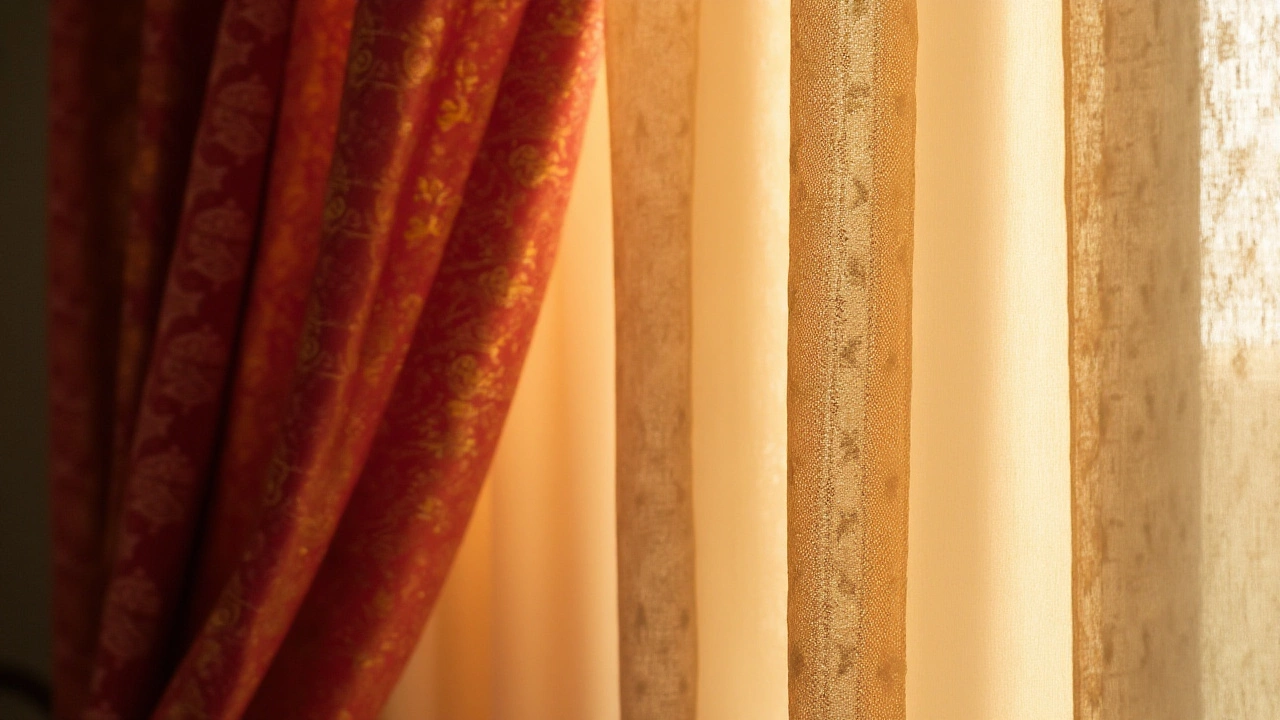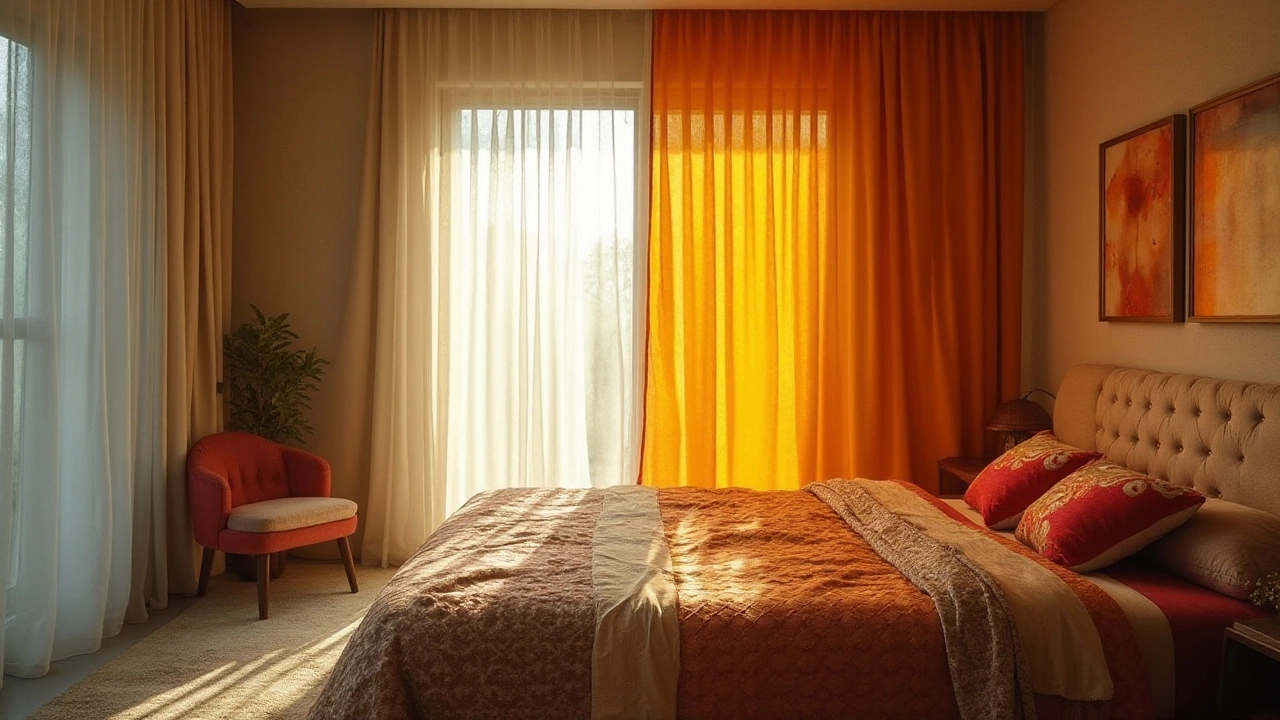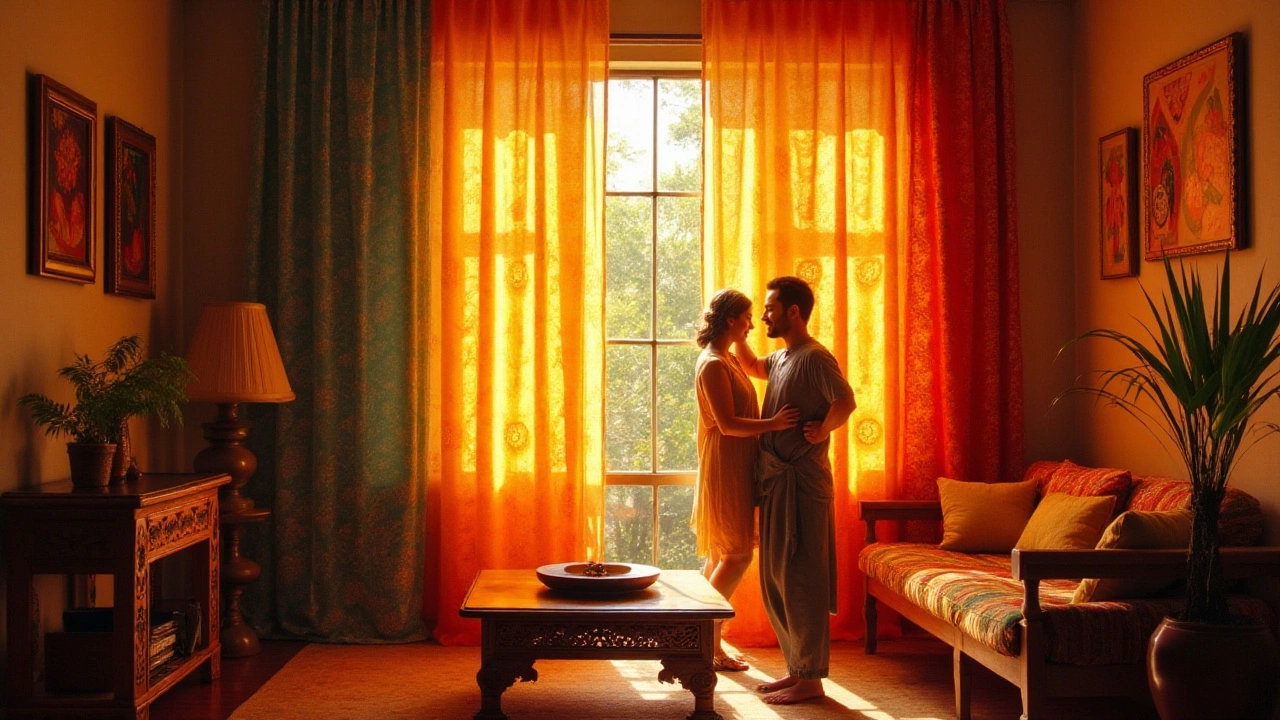When it comes to hanging curtains, the question of which side should face outside may not seem important at first glance. However, this decision can profoundly affect the appearance and functionality of a living space. Each side of a curtain serves a purpose and understanding their differences can transform your rooms.
Many assume that the decorative side should always face inward, yet doing so might not always be the best choice. Factors such as how light interacts with the fabric or how heat and cold are managed can offer practical insights when making a decision.
A balance of beauty and utility can breathe new life into any room. Additionally, homeowners should consider maintenance requirements and any environmental influences that might affect curtain longevity and performance.
- Understanding Curtain Sides
- Functional Aspects of Curtain Positioning
- Aesthetic Considerations
- Impact on Lighting and Privacy
- Environmental and Maintenance Factors
Understanding Curtain Sides
When embarking on the journey of curtain design, a frequently underrated decision awaits: determining which side of your curtain should face the world. Curtains are not merely draped fabric; they are the silent mood-setters of a room. Each side has its specific construction and design that contributes to the overall atmosphere of a space. The front side, often decorated, is typically designed with aesthetic appeal in mind. This side might include vibrant patterns or rich textures that add character to the room when it faces inward. This side's presence can transform mundane interiors into something exciting and dynamic.
The reverse side, by contrast, often serves a functional purpose. It's generally crafted from materials intended to protect the living space from harsh elements. This might include lining that provides thermal insulation or blocks ultraviolet rays. Some curtain designs incorporate a thermal backing on the reverse side, which helps manage room temperature effectively by preventing heat from escaping or entering too quickly. Homeowners aiming for energy efficiency might find this option particularly appealing as it can help reduce heating and cooling costs substantially.
Deciphering the Dual Nature of Curtains
Every pair of curtains operates with a duality—its dual sides performing different roles. Many people do not realize that choosing the right side to face outward affects both durability and utility. For example, curtain materials like velvet are best enjoyed facing inward due to their soft and luxurious texture, while their less glamorous backs are treated to enhance durability. On the contrary, sheers, which are all about diffusing light gently into a room, are designed to have both sides equally display their filmy elegance. A fascinating aspect of two-sided curtains is the interplay of color and form against varying light conditions across day and night. According to renowned interior designer Amy Lau, how we perceive color and shape in our living spaces changes under different lighting conditions.
"Curtains are an art form. They interact with light uniquely, changing the mood and feel of a room through their color and design," she discusses in an interview on the nuances of interior decor.
Interestingly, statistics reflect that clarifying which side of the curtain should face out often enhances longevity too. A survey of home decor experts reveals that 65% advocate for lining-oriented exteriors to protect vibrant designs from being compromised by sunlight and dust over time. Here, both aesthetic and practical considerations of curtain sides give us insight into how homes can be made more efficient and welcoming. Making an informed choice about curtain orientation ensures that all facets—from style to functionality—are seamlessly blended to benefit both household members and guests alike. As you explore the world of curtain sides, remember this seemingly minor decision can echo profoundly in creating a harmonious and personalized living environment.
Functional Aspects of Curtain Positioning
When deciding which side of the curtain should face outward, several functional aspects come into play. One of the primary considerations is the impact on temperature regulation within the home. Curtains serve not just as decorative elements, but also as thermal insulators. Depending on the fabric, a curtain can significantly influence how well a room retains heat during the winter or stays cool during the summer. For instance, curtains with a thermal lining should face inwards, as this side is specifically designed to insulate. On the other hand, if the curtain is intended to reflect sunlight, the reflective side should be placed outward to handle heat absorption effectively.
Another functional aspect to consider is light control. Curtains can be crucial in managing the amount of natural light that enters a room. In some cases, a sheer layer is combined with a heavier drapery, requiring one to intelligently decide which layer is outward-facing. This decision impacts not only brightness levels but also how UV rays affect your furniture and flooring. Heavy curtains might be ideal facing outwards if the goal is to darken a room, creating a cozy home-theater environment or facilitating restful sleep. Conversely, if you prefer more natural light, the sheer side facing out can effectively filter the sun’s rays.
Privacy Considerations
Privacy is another critical function that demands attention when positioning your curtains. Depending on the fabric's opacity, certain curtain sides might afford better privacy than others. A detailed brocade pattern on thicker fabric will not only add aesthetic appeal to your interior but also offer excellent privacy should it face outwards. However, in public-facing windows where visual aesthetics from the outside matter as well, a plain or neutral side facing out might be more suitable, aligning the curtain’s appearance with your overall home decor.
"Curtains aren't just about keeping sunshine out; they're about privacy and comfort, a core part of any interior design." - Anonymous Home Design Expert
One must also consider acoustic qualities. Curtains are surprisingly good at muffling sound, making them a dual-purpose addition for both light and sound control. In bustling environments or homes near busy streets, thicker, denser fabrics can be positioned to absorb noise more effectively, a necessity for tranquility and peace.
Ultimately, assessing the curtain’s intended function—be it light regulation, privacy, or sound dampening—can significantly affect which side faces outwards. It's not merely an aesthetic choice but a decision that can enhance the living quality within one’s home environment.

Aesthetic Considerations
When delving into the world of curtain design, aesthetics play an undeniably crucial role. The way a curtain looks can elevate the entire ambiance of a room. Choosing which side of a curtain should face outside often depends on the visual impact you desire. The outward-facing side of a curtain interacts with the outside world, giving passersby or neighbors a glimpse into your home's style and character. Ensuring this view is pleasing can add an additional layer of beauty to your exterior vista.
Many homeowners gravitate towards allowing the decorative, colorful, or patterned side of the curtains to be visible inside, which caters to the aesthetic preferences of the household members and visitors. This inside-facing allure is typically anchored around matching existing home decor, furniture styles, or wall colors. Conversely, an increasingly popular design trend is to showcase the patterned or boldly colored sides externally. This not only enhances the home's curb appeal but also makes a statement that your home values the outside view as much as the internal one.
Interestingly, the flexibility of some modern curtain designs allows them to be dual-sided, where both sides carry unique decorative elements. This provides versatility, offering the homeowner options for altering aesthetics without the need for a replacement. Famed interior designer Martha Schwartz once mentioned,
"Every element you can see and touch within your home should tell a subtle part of its story."This exemplifies the notion that the outward appearance of a curtain can convey a story to the outside world, reflecting the unique taste and style preferences of those within.
Additionally, eye-catching designs such as trellis patterns, geometric prints, or even soft florals can have a dramatic effect when displayed externally on curtains. Some homeowners may choose to synchronize these external views with the seasons—vibrant yellows and oranges for summer, muted pastels for spring, or earthy tones for autumn. This dynamic approach not only boasts visual appeal but keeps the theme fresh and aligned with nature's own changes. While interior aesthetics ensure personal comfort and admiration, maximizing the potential beauty visible from the outside is an equally rewarding venture.
Impact on Lighting and Privacy
One of the most significant considerations when deciding which side of the curtains should face outside pertains to how they influence lighting and privacy in the home. The relationship between curtain orientation and sunlight is profound. It's not just about blocking or letting in the light; it's about creating a mood and protecting personal spaces. When the brighter, more colorful side of a curtain faces outward, it can sometimes attract and reflect more sunlight, gently illuminating the room with a softer glow. Conversely, allowing the darker or patterned side to face outwards can absorb excess light, creating a cozier, dimmer ambiance perfect for bedrooms or living spaces in need of a laid-back vibe.
The type of fabric you choose can also transform how your curtains interact with natural light. Materials like lace or sheer tend to diffuse light rather than block it completely, turning a harsh midday sun into a warm, welcoming glow. On the other hand, thick, heavy fabrics like velvet can eliminate light almost entirely, offering privacy and insulation. Privacy, after all, is an essential element in any household. Your choice of curtain orientation can significantly impact how secure you feel in your own home. For those living in bustling urban environments, allowing the design-facing outward might conceal the activities inside from curious eyes outside.
There’s an intriguing dynamic between lighting and privacy which has often been discussed among interior designers. In fact, Malcolm James Kutner, an esteemed name in home decor, notes,
"Curtains are not just decorative elements; they're an extension of your lived experience, molding light and shadow to meet lifestyle needs while ensuring the sanctity and privacy of your personal space."The balance between soaking up enough daylight and maintaining seclusion is crucial, especially as it directly influences our daily rhythm and comfort. With the winters often being harsh and light retention valuable, residents in higher latitude locations might opt for curtain orientations that maximize sunlight absorption, particularly during shorter days.
Alongside the priorities of lighting and privacy, the evolving weather conditions throughout the year affect how you might want to position your curtains. In the summer, you might prefer longer exposure to sunlight to enhance natural warmth and light, while during the cold winters, minimizing heat loss while maintaining privacy might become more pertinent. Maximizing these elements might involve a bit of trial and effort, adjusting and re-evaluating the effect of curtain choices as seasons change, ultimately finding a balance that suits your personal lifestyle and enhances your home comfort.

Environmental and Maintenance Factors
Deciding which side of the curtain should face outside involves understanding the environmental impact and maintenance concerns associated with your choice. For areas that experience harsh weather conditions or high sun exposure, curtain orientation can play a significant role in energy efficiency. Curtains facing direct sunlight should reflect heat during the summer and preserve warmth in the winter. Curtain orientation can make a difference in your heating and cooling bills.
When it comes to maintenance, the way you hang your curtains can influence their lifespan. Fabrics exposed directly to sunlight are prone to fading and material degradation over time, especially vibrant or dark colors. This is where lining comes in handy. A quality lining not only protects the curtain fabric from UV rays but also adds an extra layer of insulation against temperature fluctuations. Regular maintenance means occasionally swapping sides if curtains are reversible, or rotating curtains among rooms to ensure even wear.
It's equally important to consider how pollution and weather conditions like rain, snow, or dust storms impact exterior-facing fabrics. For example, pollutants can settle on your curtains, making them look dull if exposed to the outside elements constantly. A practical measure is to choose curtain designs with materials that are easy to clean and maintain. Synthetic blends, for instance, often provide beneficial properties like wrinkle resistance and low maintenance, ideal for dynamic environments.
Choosing Materials for Environmental Resilience
Choosing environmentally resilient materials can be crucial for curtain longevity. Natural fibers like cotton and linen may be appealing due to their environmental-friendly production; however, they might not hold up as well against intensive exposure compared to synthetic options. Consider the local climate and room orientation before selecting materials. An interesting table might illustrate how different materials hold up under environmental pressures:| Material | Sun Resistance | Weather Durability | Ease of Maintenance |
|---|---|---|---|
| Cotton | Low | Low | Medium |
| Polyester | High | High | High |
| Silk | Low | Low | Low |
As you plan your curtain installation, consider seeking advice from someone with experience in home decor. According to interior design expert Sarah Heering, "The key to choosing the right curtain fabric is to factor in the amount of direct sunlight and weather exposure your room faces. Curtains should not only suit your style but also meet practical needs."
